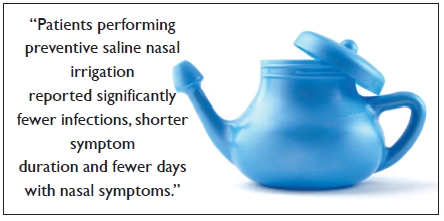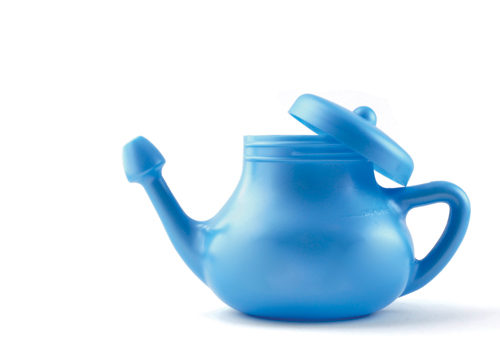
Have you ever had water enter your nose while swimming? The feeling is uncomfortable and often unexpected. However, more and more people are looking to cleanse their nasal passages with water to relieve their nasal symptoms. If done properly, the process isn’t uncomfortable in any way, and many find it soothing.
Known as saline nasal irrigation, this type of regimen may be an option for cold and allergy sufferers and those with respiratory issues. According to the peer-reviewed journal, American Family Physicians, “nasal irrigation with liquid saline is used to manage symptoms associated with chronic rhino-sinusitis” (1). The instrument often used for saline nasal irrigation is a neti pot. In one study, researchers surveyed 330 family physicians about saline nasal irrigation and 87% recommended it to their patients for a variety of conditions.
Who Can Benefit?
Though not a cure, there are several common situations in which individuals can benefit from using a neti pot. Chronic rhino-sinusitis occurs when the sinuses are swollen for longer than 12 weeks and is the “most common indication for saline nasal irrigation” (1). A second common reason is a viral upper respiratory tract infection (URTI) where lungs are coated in mucus due to post-nasal drip.
A randomized controlled trial of 60 adults focused on and evaluated the effectiveness of using a saline solution as a preventive therapy (1).
“Patients performing preventive saline nasal irrigation reported significantly fewer infections, shorter symptom duration and fewer days with nasal symptoms compared with those who did not perform preventive nasal irrigation,” stated the journal article (1). Those with allergic rhinitis, more commonly known as allergies, also benefit from neti pots. The article explains that patients with a history of allergy symptoms had improved symptoms when using saline nasal irrigation (1).
How Do They Work?
A neti pot is similar to the shape of a teapot, only smaller and elongated. When using a neti pot, mix about 16 ounces of lukewarm sterile water with one teaspoon of salt (2). Commercially prepared solutions for neti pots are also available, some of which contain xylitol (a natural ingredient known to prevent bacterial adhesion and promote respiratory health). Once the neti pot is filled, tilt your head at a 45-degree angle over a sink or tub and pour the solution through the nostril closest to the ceiling. The fluid will flow through the nasal cavity and out the other nostril, and will help flush out any mucus in the nose. Continue this process several times on one nostril and then switch sides. After, blow your nose to push out any extra solution or mucus (2).
At times, the saline solution may overflow into the throat, but it is safe and should not be a concern.
Of course, there are some precautionary measures that should be taken when using a neti pot. Always make sure to use distilled, sterile or boiled (and cooled) water to create the irrigation solution.
To prevent infection, proper care must be executed when using and storing the neti pot. Hand-washing the device is best. Be sure to rinse the irrigation device in distilled, sterile or previously boiled water and then air dry the neti pot. In a CBS news report, Steven Osborne, M.D., a medical officer in FDA’s Center for Devices and Radiological Health, said “boiling the water for three to five minutes and then cooling it until it is lukewarm can help get rid of unwanted organisms. Making sure the neti pot is completely dry and cleaning it with the safe water listed above can also help prevent infection” (3).
Neti pots are available in your local natural products store and do not require a prescription, though you should always get the green light from your physician. The cost of a neti pot is usually between $10 and $30, depending on the model. WF
References
1. D. Rabago and A. Zgierska, “Saline Nasal Irrigation for Upper Respiratory Conditions,” Amer. Fam. Phys. 80 (10), 1117–1119 (2009).
2. “Help for Sinus Pain and Pressure,” www.webmd.com/allergies/
sinus-pain-pressure-11/neti-pots?page=1, accessed Apr. 26, 2013.
3. M. Castillo, “Tap Water in Neti Pots Behind Two Brain-Eating Amoeba Deaths in 2011, Investigation Finds,” Aug. 23, 2012, www.cbsnews.com/8301-504763_162-57499285-10391704/tap-water-in-neti-pots-behind-two-brain-eating-amoeba-deaths-in-2011-investigation-finds, accessed Apr. 26, 2013.
Published in WholeFoods Magazine, October 2013










